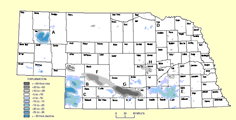Natural Resources, School of

Conservation and Survey Division: Faculty and Staff Publications
Document Type
Article
Date of this Version
9-2018
Citation
Szilagyi, J., 2018, County-wide Assessment of Irrigation Expansion on Air Temperature, Humidity and Evapotranspiration Rates in Nebraska, 1979-2015. University of Nebraska–Lincoln, Conservation and Survey Division, Bulletin 10 (New Series), 24 p.
Abstract
Total irrigated land area has been expanding in Nebraska over the last 40 years, propelling the state into a leading position within the US in terms of irrigated acreages. Typically, those counties which display the largest degree of irrigation development had a significant portion of their land area already irrigated in 1978. Large-scale irrigation in Nebraska affects its atmospheric environment. During the typical irrigation season of May to August, counties with the largest rate of irrigation expansion have cooled by about 0.2 – 0.3 °F per decade in the summer months of June, July and August, while counties with the smallest rate of development warmed by about 0.15 °F per decade during the same period. In the summer months, relative humidity increased three times faster, by about 1.5 % per decade, in well irrigated counties than in least irrigated ones. Finally, ET rates increased by 0.05 inch (1.3 mm) per decade in well-irrigated counties while they stayed about constant in the least irrigated ones.
Included in
Geology Commons, Geomorphology Commons, Hydrology Commons, Paleontology Commons, Sedimentology Commons, Soil Science Commons, Stratigraphy Commons


Comments
CB-10 (NS)